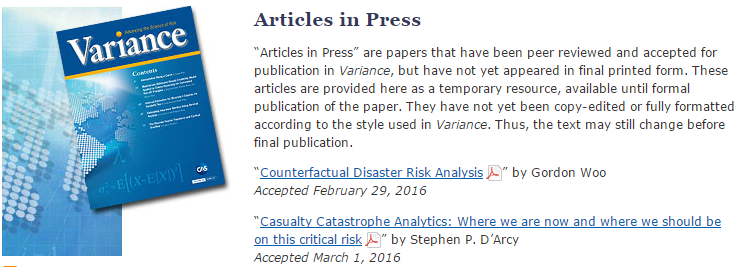In this blog post, I hope to accomplish two things at once, both involving CAS research.
First, I’m happy to share that we have added a page to the website for our peer-reviewed research journal, Variance, titled “Articles in Press.” Currently, because of copyediting and the lengthy publication process, we have a collection of accepted Variance papers that could take as much as a year to formally publish. This is good-news/bad-news: there are some very interesting articles in the pipeline, but logistical requirements will delay getting them to our readers. In an effort to make these accepted papers available and of benefit to the membership as soon as possible, we will now post PDF files of them upon acceptance. While the posted papers will not yet have been fully copyedited this is a common practice among scholarly journals, and indeed many authors post their own drafts as discussion papers even before submission to or acceptance by journals.
The second purpose of this blog post is related to the initial set of papers we have posted on this new webpage. Certainly, most of the articles published by the CAS – in Variance, in E-Forum, as part of call paper programs – are quantitative in nature. I suppose that’s an occupational hazard of ours! And I imagine I speak for all of us when I say that a quantitative paper, when clear and well-written, and when it addresses an interesting area with potential relevance and applicability to our real-world actuarial work, is virtually a thing of beauty.
But actuarial research need not always take that form. Indeed, there is room for research and papers with many different levels of mathematical density and content. And a couple of very interesting, thought-provoking articles, each with little-to-no mathematics in its pages, happen to be among the first to be posted on our new “Articles in Press” page.
“Counterfactual Disaster Risk Analysis” by Gordon Woo, a catastrophist at Risk Management Solutions, is an immensely readable and fascinating advocacy for using “counterfactual history” to develop possible alternative future catastrophe scenarios. It’s a compelling discussion and collection of examples for imaginatively considering “the dynamic perturbations that might transition a system to a disaster state.”
Do you enjoy science fiction? Ever thought that Hari Seldon’s “psychohistory” would be a great Foundation for actuaries in a fictitious future? Then I think you’ll enjoy and benefit from the Woo paper. (Actually, I think you’ll enjoy and benefit from it even if you have no idea what I was referring to two sentences ago!)
“Casualty Catastrophe Analytics” by Steve D’Arcy is another paper that contemplates important risk issues in a thoughtful, non-quantitative way. This is an area of risk that has immense loss potential, and that needs more and more attention, including thoughtful consideration of past, current, and future approaches to identifying, quantifying, and managing these risks. Steve’s article provides this context and foundation for actuarial work in casualty catastrophe analytics.
I heartily commend to you each of these articles, now available at Variance’s “Articles in Press” page. And with a current pipeline of around twenty papers, there are a lot more papers coming soon!



